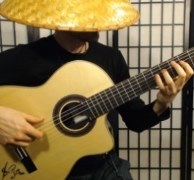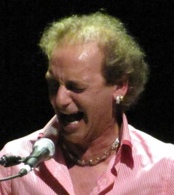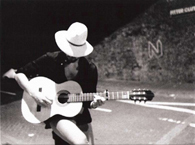Welcome to one of the most active flamenco sites on the Internet. Guests can read most posts but if you want to participate click here to register.
This site is dedicated to the memory of Paco de Lucía, Ron Mitchell, Guy Williams, Linda Elvira, Philip John Lee, Craig Eros, Ben Woods, David Serva and Tom Blackshear who went ahead of us.
We receive 12,200 visitors a month from 200 countries and 1.7 million page impressions a year. To advertise on this site please contact us.
|

|
|
apoyando thumb during arpeggios
|
You are logged in as Guest
|
|
Users viewing this topic: none
|
|
Login  | |
|

   
mark indigo
Posts: 3625
Joined: Dec. 5 2007

|
 RE: apoyando thumb during arpeggios (in reply to Ricardo) RE: apoyando thumb during arpeggios (in reply to Ricardo)
|
|
|
quote:
It means "easier said than done".
But that's not what I'm saying at all. Did you miss the bit about "patient slow practise" or just react to the word "pretends"?quote:
Relearning techniques is often harder for advanced players than for beginners because you have to unlearn what used to be natural. quote:
if the advanced player "pretends" it's a new technique, and puts in the patient slow practise that went in to learning the technique initially I don't think it has to be any harder, or take any longer.
If an otherwise advanced player has learned with a wrong technique, say free stroke with the thumb in arpegio, then I am suggesting they don't need to do more than the practise they have already put in to learning it that way - which is probably a lot of practise!
As I understand it practise strengthens the neural pathways for an activity or technique, so a new technique will have a weak neural pathway and need time and effort putting in. Whether the time and effort are well spent, productive and successful will depend a lot on the mental approach.
I think sometimes the more advanced someone is the less time they think they should need to put in to change a technique, so they will then get poor results and end up taking longer than it should.
The other thing that I think gets in the way of changing a technique, such as switching from free stroke to rest stroke with the thumb in arpegio is the concept of having to "unlearn" the old way of doing it. As long as the player has this in mind, that they've got to "unlearn the old way" or "don't do free stroke with the thumb" they will keep on calling up that old program they have spent many hours practising, and then wonder why they keep on playing free stroke with the thumb instead of rest stroke with the thumb, and it seems so hard to change.
Better, IMO, to approach it as a "new" technique, and put in the necessary time and energy, than to go round in circles trying to "unlearn" something.
DISCLAIMER: I don't have a degree in neuro-science, but I have had a lot of in depth conversations with people who subscribe to neuro-science journals and work in performance enhancement and performance psychology areas. All of the above is conjecture and opinion based on conversations with said individuals, and a general reading of material on practise, performance, technique etc. I don't have any test results, bibliographies or grid references to "prove" any of the above. I think they are good ideas worth further investigation.
_____________________________
|
|
|
|
REPORT THIS POST AS INAPPROPRIATE |
Date Dec. 5 2017 8:56:41
 |
|

   
Erik van Goch
Posts: 1787
Joined: Jul. 17 2012
From: Netherlands

|
 RE: apoyando thumb during arpeggios (in reply to mark indigo) RE: apoyando thumb during arpeggios (in reply to mark indigo)
|
|
|
quote:
ORIGINAL: mark indigo
As I understand it practise strengthens the neural pathways for an activity or technique, so a new technique will have a weak neural pathway and need time and effort putting in. Whether the time and effort are well spent, productive and successful will depend a lot on the mental approach.
The other thing that I think gets in the way of changing a technique, such as switching from free stroke to rest stroke with the thumb in arpegio is the concept of having to "unlearn" the old way of doing it. As long as the player has this in mind, that they've got to "unlearn the old way" or "don't do free stroke with the thumb" they will keep on callikng up that old program they have spent many hours practising, and then wonder why they keep on playing free stroke with the thumb instead of rest stroke with the thumb, and it seems so hard to change.
Better, IMO, to approach it as a "new" technique, and put in the necessary time and energy, than to go round in circles trying to "unlearn" something.
Spot on. As I used to tell my students, you start with a smal animal trail end you end up with a six lane highway *. As a matter of fact building up that neural pathway can be done both physically and mentally (thinking of doing a movement gives the same neural respons as doing the movement for real). As soon as I'm able to visualize/perform the action in my mind I favor that over doing it for real because it is less polluted with mistakes and translation mistakes. In my better days I could play complete pieces in my head as real as real can be (even feeling the physical contact with guitar and strings and the resonance of the guitar). Singing or playing a phrase a couple of times in your head can be a 1000 times more effective then playing it for real.
Practice cements what you are drilling so one better makes sure one is drilling good habits and not bad habits that have to be unlearned later on. Another wisdom tile in my teaching room is "repeating only makes sence if something is worth being repeated" or like a good bass player once said you must make it a habit not a single note escapes your instrument uncontrolled (pairing the right thought to the right action at first is more important as playing that note in time. It's way more easy to change timing once technical and mental control is achieved then to try to spot and improve technical flaws when playing in a strict time frame like a metronome).
It's important to know the human brain can handle only 1 thing at the time so for the best result study only one thing at the time. I took it to the extreme. For studying arpeggio for instance you don't need a left hand. It involves very focused study and control of things like proper relaxation and using one's natural biomechachanics. Fingers move in circulair movemends and where your finger ends up (and how effective your minimal input is) fully depends on how you project that circle. Key point are the big knukkles. Depending on how you position the big knukkles in relation to the string being plugged the fingers will either go away from the guitar or go into the guitar resulting in either tirando or apoyando. Best thing is to use what I call my walking hand (the relaxed hand and finger line up you have when walking) and bring that lineup to the place of the action. Depending on how you place your big knukkles (straight above the string being plugged is a good starting point) the circulair projection/outcome when moving your fingers wil turn out to be effective or less effective. For arpeggio best thing is to operate on the edge of tirando and apoyando (allowing selected fingers to play with a rest stroke) so tilting your hand 1 mm can bring you from one option into the other.
So improving yourself starts with studying ones natural biomechanics, hand lineup and proper relaxation. Since the brain can only handle 1 thing at the time try to break up things to small elements that are studied separately and with full focus (the smaller the object of your focus the bigger the result) Gradually start combining things and study more complex things but don't alow things to happen out of your control. One of the reasons I managed to completely reform myself in only 3 weeks once was starting from scratch and doing only 1 thing at the time, we're possible by means of mental visualisation. Old/unwanted habits and thoughts must be prevented at all costs so don't spoil an hour of serious (re)programming by doing some uncontrolled fun playing later on allowing the verry same bad habits to pop up you wanted to prevent.
Take into account the human brain needs about 6 hours to digest new information after you abandoned it. You can do whatever you want, read a book, watch a movie, eat or pick up another guitar challenge but don't, I repeat, don't come back to that first challenging exercise or pice of music before the first set is digested because you'd be better of just restricting to that first set or having a break of at least 6 hours. Things enough to do because to become great one must spent some quality time studying/improving one's technique (focus on relaxation, natural biomechanics) tonal pallet (exploring sound and dynamics) and expressing abilities (combining the previous 2).
* when learning a completely new thing the neurological pathway is still a kind of a blank sheet. Every time you repeat the new movement (physically or even better by visualizing it in your head) your brain keeps count and once a certain amount of tally marks is reached the brain seems to instruct the nerve system to increase the amount of nerves specializing in that task, verry much like a traffic counter might lead to building better infrastructure on places that show a growing demand of traffic. The trick is to make sure you cement the right habits when that neural infrastructure is build.
I had the fortune that when I reprogrammed myself I happened to develop and integrate a series of exercises that imo are verry effective in upgrading ones system. I call them my micro-exercises.
It all started with a classical guitarist showing me the folowing exercise. Put your lefthand finger on a string in one of the higher positions and push it towards the fret but in stead of doing so on normal spead try do walk that distance as slowly as possible (so slow you can't see the movement but without standing still). Once you reached the fret hold it for a while (with or without giving it the little extra power normally needed to get a clear sound) and then go back the same way, as slowly as possibly without standing still. I can tell you there is much to learn from those 2 mm that separates the string from the fret. (I call that the twilight zone). The first thing I would do when touching the guitar was put a finger on a string without pressing and then lift it. Next pres it a bit and go back to starting position. Next I would press it to halfway the twilight zone and hold it there for a while, enjoying the amount of energy floating from my finger into the string and the other way around. Next I would do the as slowly as possible exercise mentioned above.
I found this verry demanding and a real chalange for my nerve system and even better a chalange leading to new and highly sensitive nerve systems (keep in mind handling the string within the twilight one demands less pressing power then "normal" playing which in the end should be only that more that is needed to get a clear sound). From that first exercise I developed a whole series of exercises for both left and right hand paving both a better awareness understanding and control of my actions and natural biomechanics as wel cementing a new and highly sensitive nerve system supporting those actions. All it takes is smart thinking and lots of focus to explore and embrace one's natural biomechanics and relaxation.
_____________________________
The smaller the object of your focus the bigger the result.
|
|
|
|
REPORT THIS POST AS INAPPROPRIATE |
Date Mar. 22 2022 4:42:49
 |
|
 New Messages New Messages |
 No New Messages No New Messages |
 Hot Topic w/ New Messages Hot Topic w/ New Messages |
 Hot Topic w/o New Messages Hot Topic w/o New Messages |
 Locked w/ New Messages Locked w/ New Messages |
 Locked w/o New Messages Locked w/o New Messages |
|
 Post New Thread
Post New Thread
 Reply to Message
Reply to Message
 Post New Poll
Post New Poll
 Submit Vote
Submit Vote
 Delete My Own Post
Delete My Own Post
 Delete My Own Thread
Delete My Own Thread
 Rate Posts
Rate Posts
|
|
|
Forum Software powered by ASP Playground Advanced Edition 2.0.5
Copyright © 2000 - 2003 ASPPlayground.NET |
0.125 secs.
|


 Printable Version
Printable Version














 New Messages
New Messages No New Messages
No New Messages Hot Topic w/ New Messages
Hot Topic w/ New Messages Hot Topic w/o New Messages
Hot Topic w/o New Messages Locked w/ New Messages
Locked w/ New Messages Locked w/o New Messages
Locked w/o New Messages Post New Thread
Post New Thread